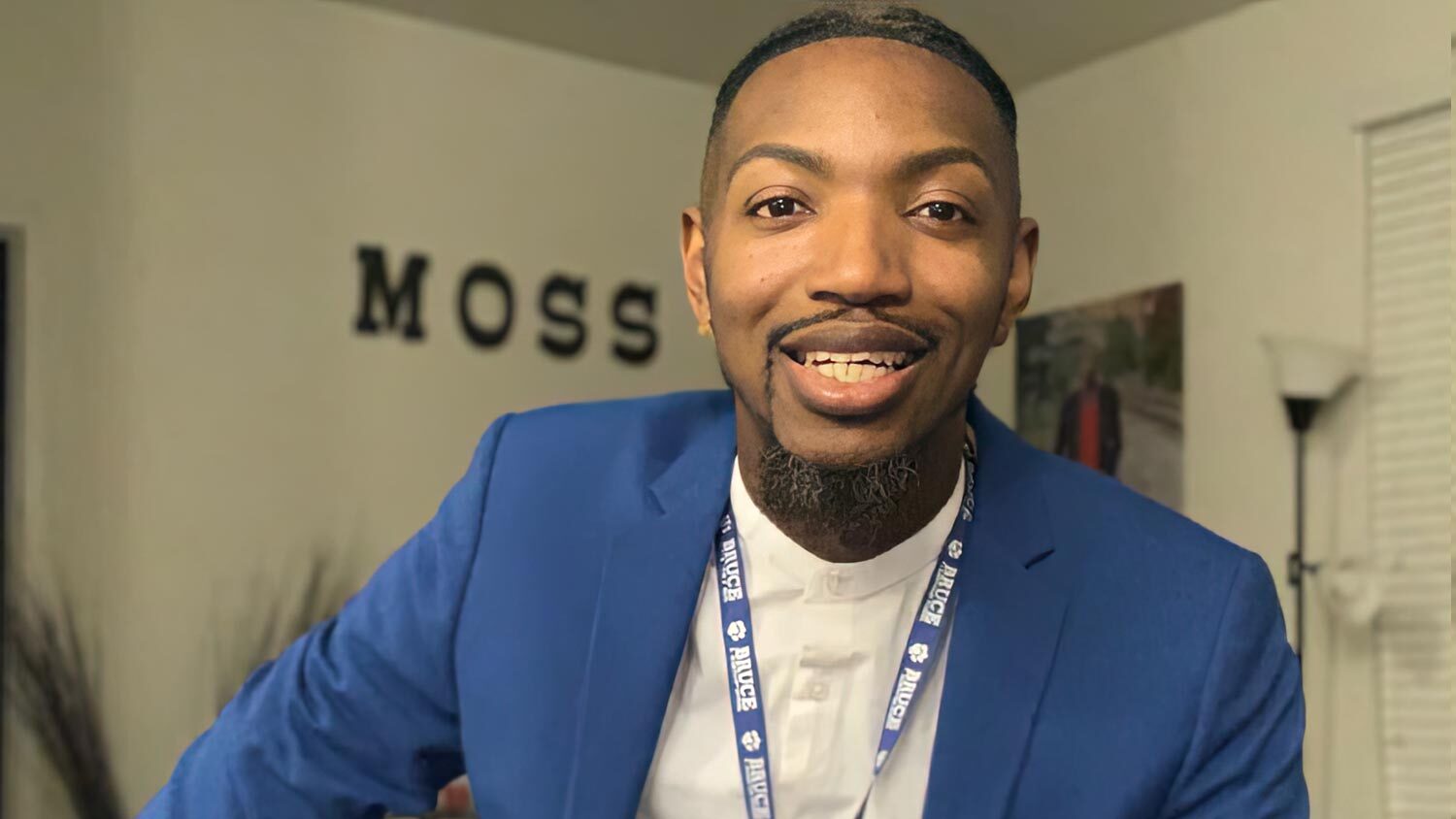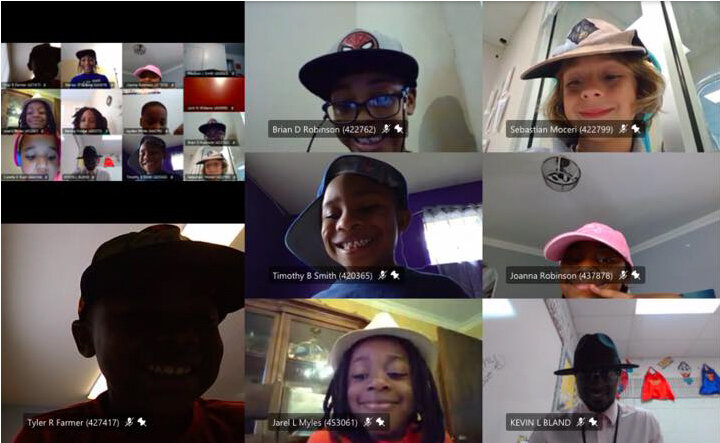Cultivating Joy at Bruce Elementary School

Tonight, the children of Bruce Elementary School in Memphis will read a bedtime story together.
They’ll huddle around their district-issued Chromebooks and wait for a familiar, loving face to fill the screen. Their principal, Dr. Archie Moss, has been reading to them every Tuesday night for two years. The pandemic and the move to fully remote learning did not stymie this school community’s rituals. For Dr. Moss and his team of devoted educators, it’s part of a deeply intentional vision that all children at Bruce “feel seen, heard, and deeply known.”
With each passing week, the verdict on remote learning becomes cloudier. “Zoom burnout” is real. Keeping engagement high is exhausting for teachers and children. And we’re all collectively worried about deepening inequity and learning loss, the toll from which we won’t know for years to come. This is why this video of Dr. Moss, his teachers, and students seemingly thriving in the remote environment made me eager to learn more. Lighting in a bottle: what’s behind teachers doing some of their best work remotely, the principal’s endearing and effective rap game, family and community engagement that’s even higher than pre-pandemic, and a school poised to sustain its reinventing efforts far into the future?
Bruce Elementary, which serves 543 PK-5th graders, is a storied school in the midtown neighborhood of Memphis. In 1961, it was one of the city’s first schools to racially integrate. Today, it is at the fulcrum of a familiar divide – turn left out of the school’s front doors and you’ll hit the monied medical center enclave; turn right and you’ll find a community working hard to stay vibrant. The children at Bruce come from a wide variety of circumstances: 10% are temporarily displaced or unhoused, 15% are English Language learners, and 98% receive free or reduced lunch. Bruce Elementary is more than a school building – it is a thriving, warm, and child-centric network of young people and the adults who serve them.
When I left the Dean of Students role at a middle school, I realized that even as a Black man, I was further reinforcing the school to prison pipeline. My role required me to regulate and police behavior in ways that shook my faith in education. I knew there had to be another way.
Dr. Archie Moss
“When I left the Dean of Students role at a middle school,” Dr. Moss reflects, “I realized that even as a Black man, I was further reinforcing the school to prison pipeline. My role required me to regulate and police behavior in ways that shook my faith in education. I knew there had to be another way.” That “other way” runs against the conveyor belt of conventional thinking about the purpose of and methods for building school culture. For Dr. Moss, cultivating joy is the best way to build conditions where children can be holistically successful in school and life. This bedrock of joy fosters the sense of belonging at the heart of Connection and Community, enabling young people and adults to know each other — to be seen, heard, and deeply known — and from there, enabling another critical Leap: inflexible systems to Customization. The pandemic shed light on a critical insight the Bruce team has been leaning into for years: we need to move beyond thinking about school culture as the rituals, expectations, and discipline practices that support compliance within a one-size-fits-all model. Instead, we must cultivate cultures where we can deeply understand who children are and modify learning experiences in response to the many ways children vary in identity, motivation, and life circumstance. Customization is the embodiment of equity. And it is the way forward for Bruce.
Developing strong Connection and Community isn’t only about better behavioral management in schools; it can also be a critical strategy for deeper Customization within a learning environment.
As part of Transcend’s partnership with Teach for America’s Reinvention Lab, the Bruce team sought support as they developed virtual reopening plans for the fall and began the work of reinventing Bruce’s learning environment beyond COVID. Neshellda Johnson, a teacher, describes virtual learning as an opportunity to “take lemons and make lemonade.” For her, customization is a “philosophy for ensuring we meet diverse needs, learning levels, interests, and technological abilities.” The need for this is even more pronounced in a remote setting. Mrs. Johnson prepares the learning environment for both synchronous and asynchronous learning, depending on what learners need. She thoughtfully incorporates breakout rooms with the help of her co-teacher, who can lead at the pace of student need. Remote learning helped to fertilize the seeds already planted for Mrs. Johnson and other teachers. It has also made them more attuned to childrens’ lives at home. “I’ve had to really understand different [manifestations of] trauma now that they are home. For some students, school is a safe haven. I’ve had to extend a lot of grace and tell them, ‘I can’t hug you, but I can love you virtually.’ I’ll say, ‘Let’s do something that makes you feel loved.’”
Remote learning (and the new technological tools that enable it) can be used to advance Customization through synchronous and asynchronous learner experiences.

Other school-wide systems and practices support Bruce’s reinventing towards a more customized learning experience. They are piloting “ability grouping,” moving away from strictly organizing students by age and grade band and instead considering their learning needs. Intervention teachers facilitate these blocks of learning, which breaks down students’ association between grade-level teachers and their support. Bruce is piloting this remotely now, but their ongoing reinventing planning focuses on setting up the entire learning environment to serve young people in this more personalized, flexible way. Bruce is the only elementary school in town with advisory, a regular small group gathering typically reserved for middle and high school. They revamped this structure so that it is no longer a purely administrative place, taking attendance and other tasks, but a structure that focuses on real community building and socio-emotional learning. Children participate in pro-social community games, paired reflections with peers, emotional check-ins, and mindfulness.
Bruce will also leverage a move towards a full co-teaching model to lower the student-teacher ratio. Dr. Moss says, “We’re using virtual learning to test things out in really rapid ways, understand what works, what doesn’t work, and make quick adjustments. The thinking is to take small steps now so that we can make big leaps when we’re back in-person.”
The thinking is to take small steps now so that we can make big leaps when we’re back in-person.
Dr. Moss
Counselors, teachers, support staff and families are incredibly proud of the impact of this innovation: in surveys, 85% of Bruce’s children feel respected, 83% feel included in class, 79% say they are getting along with people who are different, and 87% say they know their advisor. Attendance is steadily increasing. These are strong and encouraging results to build with children, and unsurprisingly Dr. Moss takes a similar approach with the adults. “One of the mindfulness questions that I ask teachers at our staff meeting is, ‘What are you giving yourself permission to do and receive this week?’ It really helps when at the end of the week they can reflect and really be intentional. We model as adults what we would want the kids to do.”
School communities with the strongest culture and relationships are deeply intentional about developing the habits and skills of young people and the adults who serve them.
And what does it look like to cultivate joy at Bruce? Ritual and play. Every morning begins with the ritual of reflecting on a school value, celebrating birthdays, and – on Fridays – a virtual dance party. Extracurricular activities from orchestra to step team to drumline further show the way that this learning community customizes around student interests. It’s also one of the rare learning environments I’ve seen where learning through play and hobby is seen as necessary and just as vital as academic learning. Bruce Elementary has made tremendous progress in Whole-Child Focus in rhetoric and practice, all within a traditional district environment. The road they’ve already paved towards more extraordinary and equitable learning is allowing this community to sow the seeds for even more Leaps at a time of great uncertainty in schools
The science of learning and development supports the idea that sense of belonging, constructive emotions, and limiting identity threats are all necessary for deep learning; advisory or “homeroom” structures can be used for more than attendance and other record-keeping.
It didn’t surprise me to learn that Dr. Moss had been a Dean of Culture before he took on the principalship at Bruce. In my own experience, I can recall a great number of talented Black male teachers who had been steered into similar roles, often on the unspoken (and sometimes spoken!) assumption that they could “handle behavior” better than anyone else in the building. “Culture” meant compliance. And compliance meant enforcement, and enforcement meant Black men operating from punitive authority over children. This isn’t universally true of all culture deans, of course. There are innovative actors in all roles who are sometimes able to overcome the design of their jobs. More often, though, that’s not the case in the traditional design of school. I am deeply moved as I listen and watch Dr. Moss, rapping and reading to his students with a defiant grace and palpable love, asserting everyday that his school will be about joy. And that this joy will result in children feeling seen, heard, and deeply known so that learning responds to who they are. The insight that culture and customization “travel together” also strikes me as profound. Culture is a strategy for customization, and you can work to achieve customization through culture.
The pandemic helped affirm that many of the steps Bruce has taken around culture and relationships are working. This moment has also shown how deeply diverse the needs of children are. By leveraging strong relationships and a deep sense of belonging, Bruce is setting the stage for a more customized learning environment in the future. Mrs. Johnson is hoping for a hybrid model post-COVID: “I think that will be the new normal. I’m very interested to see how we can marry remote learning with traditional face-to-face.”
What Bruce Elementary is teaching us about roads to reinventing
Developing strong Connection and Community isn’t only about better behavioral management in schools; it can also be a critical strategy for deeper Customization within a learning environment.Remote learning (and the new technological tools that enable it) can be used to advance Customization through synchronous and asynchronous learner experiences.School communities with the strongest culture and relationships are deeply intentional about developing the habits and skills of young people and the adults who serve them.The science of learning and development supports the idea that sense of belonging, constructive emotions, and limiting identity threats are all necessary for deep learning; advisory or “homeroom” structures can be used for more than attendance and other record-keeping.
Transcend supports communities to create and spread extraordinary, equitable learning environments.

